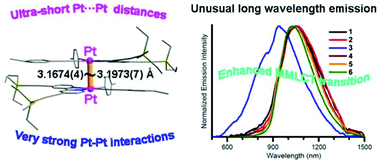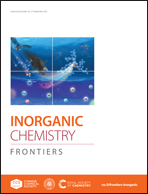Long-wavelength NIR luminescence of 2,2′-bipyridyl-Pt(ii) dimers achieved by enhanced Pt–Pt interaction†
Abstract
In this work, six Pt(II) complexes based on 4,4′-bis(triethylsilylethynyl)-2,2′-bipyridine ligand were designed and synthesized. The crystal structures of complexes 1, 2, 5 and 6 showed that these complexes adopt dimer structures with ultra-short intermolecular Pt⋯Pt distances [3.1674(4)–3.1973(7) Å]. In the solid state, all complexes exhibited long-wavelength NIR luminescence with maximum emission centered at 1045 nm for 1, 1062 nm for 2, 939 nm for 3, 1051 nm for 4, 1037 nm for 5, and 1029 nm for 6. This is the first report on the Pt(II) dimer with luminescence exceeding 1000 nm. More importantly, 1062 nm of complex 2 is the longest emission wavelength of the reported 2,2′-bipyridyl-platinum(II) complex. Furthermore, these complexes also exhibited reversible mechanoluminescence property. Systematic studies on the crystal structure, photophysical properties and PXRD patterns revealed that the long-wavelength NIR luminescence of dimers is due to the enhanced MMLCT transitions, and the mechanism of reversible mechanoluminescence property involves changes in the strength of the Pt–Pt interaction caused by reversible alteration of intermolecular Pt⋯Pt distances during the mechanical grinding-vapor absorbing process.



 Please wait while we load your content...
Please wait while we load your content...